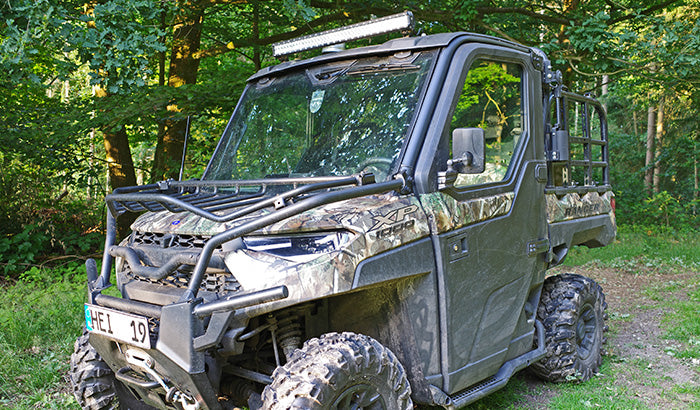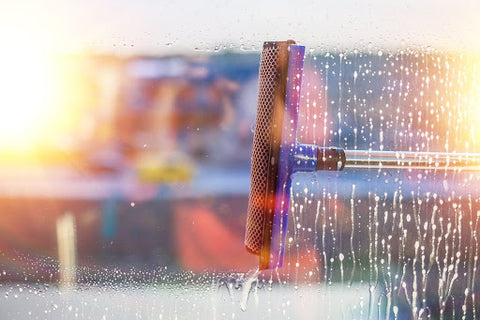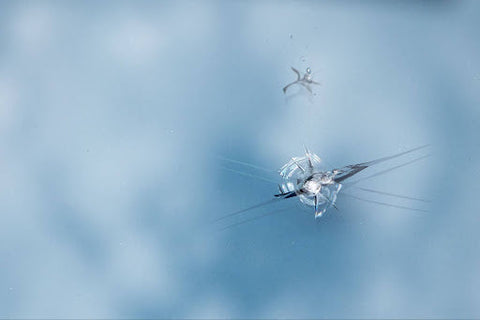Better then orginal
Top doesn't fit good in the frame or outside the frame
Easier way to secure windshield when it is down, other than that great product

Welcome to the ultimate guide to maintaining and caring for your UTV windshield, a crucial component of your off-road experience. A well-maintained windshield offers clear visibility, safety, and comfort. Good windshield maintenance prolongs the life of this investment.
Whether you're navigating dusty trails, driving over rocky terrains, or simply enjoying the great outdoors, your UTV windshield stands as your first line of defense against the elements and unforeseen obstacles.
UTV windshields come in three primary materials — polycarbonate, glass, and acrylic, each with its unique characteristics and maintenance requirements. Understanding these materials’ maintenance requirements helps you keep your UTV windshield in top condition, ride after ride.
Join us as we delve into the essentials of UTV windshield maintenance, tailored to keep your adventures safe and your views unobstructed.
When it comes to UTV windshields, the material you choose impacts your riding experience. Let's explore the three primary materials — polycarbonate, glass, and acrylic — to help you make an informed decision for your off-road companion.
Renowned for their toughness, polycarbonate windshields are up to 250 times more impact-resistant than glass and far more durable than acrylic. This material is ideal for riders who face rugged conditions, as it withstands impacts without shattering.
In terms of maintenance, polycarbonate is relatively easy to care for. It requires regular cleaning with suitable windshield cleaners to maintain clarity. You also have the option to treat it with scratch-resistant coatings for added durability. However, it's more prone to scratches if not properly maintained, so gentle cleaning is critical.
Glass offers unparalleled optical clarity and is highly resistant to scratches, making it a favorite for riders who prioritize a clear view. However, its susceptibility to shattering upon impact and heavier weight make it less ideal for rough terrains. Maintenance-wise, glass is straightforward to clean and doesn't scratch easily, but it demands careful handling and immediate replacement if it gets cracked or broken.
Acrylic windshields are lighter than glass and won't shatter upon impact, making them a good choice for casual riders. They are easier to handle and install but are more susceptible to scratches and may become hazy over time. They may require more frequent replacement than polycarbonate due to wear and tear. Like polycarbonate, plexiglass requires regular cleaning with non-abrasive materials.
Each material has its advantages and maintenance needs. Polycarbonate stands out for its durability and impact resistance, glass for its clarity and scratch resistance, and acrylic for its lightweight and shatterproof qualities. Understanding these properties will help you choose the right windshield for your UTV and ensure it stays in prime condition for your off-road adventures.

Regularly maintaining your UTV windshield ensures your safety and enhances your riding experience. A well-maintained windshield offers clear visibility, which is crucial for navigating trails safely. Maintenance also preserves the integrity and longevity of the windshield, saving you from frequent replacements and unexpected expenses.
By taking a few simple steps and conducting routine maintenance, you extend the life of your windshield and keep it functioning at its best.
Before and after each ride, inspect your windshield for any signs of damage, such as cracks, chips, or deep scratches. Detecting these issues early on allows you to intervene before they get worse.
Use a soft, microfiber cloth or a sponge to gently clean the surface with soap or an appropriate windshield cleaner. Thoroughly rinse the windshield with clean water to remove any streak-causing soap residue. Then gently dry the windshield with a clean, soft cloth. Avoid using rough materials that could scratch the surface.
Consider applying a UV protective treatment to polycarbonate and acrylic windshields to prevent yellowing and brittleness over time. For glass, try a rain repellent to improve visibility in wet conditions.
When not in use, store your UTV in a covered area to protect the windshield from environmental elements like sun, rain, and dust.
By following these routine windshield maintenance practices, you ensure that your UTV windshield remains clear, intact, and reliable for every adventure that lies ahead.
A clean windshield increases your safety on the trails. Different materials require different cleaning approaches, and using the right products and techniques is key to maintaining the clarity and longevity of your UTV windshield.
Polycarbonate windshields: Use a soft, damp cloth or sponge with mild soap and water. Avoid abrasive cleaners or cloths that could scratch the surface. Rinse thoroughly with water and dry with a soft, lint-free cloth. For tougher grime, use a polycarbonate-safe cleaner.
Glass windshields: Because glass is more forgiving, it’s safe to clean it with standard automotive glass cleaners. Use a microfiber cloth or a squeegee for streak-free results. Avoid cleaners with ammonia, as they sometimes damage surrounding materials.
Acrylic windshields: Similar to polycarbonate, use a gentle, non-abrasive cleaner. Use acrylic-specific cleaners that minimize the risk of scratches and clouding. Avoid dry wiping as it causes static and attracts more dust.

While commercial cleaners are formulated for specific materials, a DIY solution of mild soap and water is also effective, especially for polycarbonate and acrylic. However, commercial cleaners offer added benefits for stubborn stains or specialized needs like anti-fogging or UV protection.
Even with the best care, your UTV windshield might sustain minor damages. Identifying and addressing these early saves you from more significant repairs down the line.
Small scratches are often repairable. Look for fine lines that haven't penetrated deeply into the material. Repair is also an option for small chips, especially those not directly in the driver’s line of sight.
Polycarbonate and acrylic: For light scratches, use a specialized plastic polish. Apply the polish with a soft cloth in a circular motion, then buff it out. For deeper scratches, gently sand the area with fine-grit sandpaper before polishing.
Glass: It is possible to repair chips in a glass windshield. Address small chips with a glass repair kit. These kits usually contain a resin that, when applied correctly, fills the chip and prevents it from spreading.

Most UTV riders can repair minor dings or scratches on their own, but there are times when you need to call in a professional. Large cracks or deep chips, for example, require professional attention. These types of damages compromise the structural integrity of the windshield.
The location of the damage also plays a role in determining if a professional is necessary. If the damage is in the driver's line of sight, it's best to consult a professional for a safe and clear repair.
If you're unsure about the severity of the damage or the repair process, get professional advice on how to ensure the longevity and safety of your windshield.
Taking proactive steps to care for your UTV windshield is as important as addressing issues after they occur. Here are some tips to help you prevent damage and keep your windshield in top condition.
When not in use, cover your UTV with a protective cover. This helps prevent scratches and damage from environmental elements like dust, debris, and harsh weather. Windshield covers protect your windshield from the elements when your UTV is parked. They prevent dirt, dust, and debris from accumulating on the windshield, which can cause scratches when wiped off.
In addition, consider adding windshield guards or deflectors, especially if you frequently ride in areas with a lot of debris.
Regular cleaning also helps prevent windshield damage. Keeping your windshield clean is about more than visibility; it also prevents the accumulation of materials that will scratch or etch the surface over time.
Applying a protective coating adds an extra layer of defense against scratches and UV damage. For polycarbonate windshields, a UV-resistant coating prevents yellowing and brittleness.
Safe driving practices are one underestimated way to keep your windshield safe. Maintain a safe distance from other vehicles or riders to avoid flying debris that will crack or scratch your windshield.
Riding through heavily wooded areas or rocky terrains requires extra caution. Be mindful of your environment and avoid high-risk areas.
Reduce speed in harsh conditions. High speeds increase the risk of damage from flying debris. If you’re driving in wet conditions, it’s easier for your UTV to slide or crash. Slowing down helps you manage your vehicle in these conditions and is overall safer for you and your vehicle.
By following these preventive measures, you reduce the risk of damage to your UTV windshield, ensuring it remains a clear and safe barrier during your off-road adventures.
Understanding when to replace your UTV windshield is crucial for maintaining optimal safety and visibility during your rides. Here are key indicators and considerations to help you make an informed decision:
The first sign that you need a windshield replacement is large cracks or deep scratches. If these scratches or cracks impair visibility or cannot be repaired safely, then your windshield needs replacing.
Another sign you need a windshield replacement is extensive hazing or discoloration. If your windshield has become hazy or discolored to the point where it affects your ability to see clearly, it's time for a new one.
Lastly, look for signs of structural weakness. A windshield that shows signs of warping or structural weakness poses a safety risk and should be replaced immediately.

It usually costs more to replace a windshield than to repair minor damages like small chips or light scratches. However, if the repair costs start approaching the price of a new windshield, replacement becomes a more economical choice.
If you’re debating repairing or replacing your windshield, consider the long-term value and safety of your vehicle. A new windshield may be a larger upfront investment, but it ensures reliability and safety, especially if the current one has multiple repair patches.
The first thing to consider with a windshield replacement is the material used. Choose a material that suits your riding style and environment. Polycarbonate is ideal for rough terrains and demanding conditions, while glass and acrylic are suitable for less intense use.
Ensure the replacement windshield is compatible with your UTV model. A perfect fit is crucial for safety and effectiveness.
For enhanced performance, consider windshields with added features like UV protection, scratch resistance, or anti-fogging properties.
Replacing your UTV windshield at the right time enhances your riding experience and ensures your safety on every adventure.
We hope this guide empowers you to take the best care of your UTV windshield. Implementing these tips and practices will not only enhance your riding experience but also extend the life of your windshield.
At TerraRider UTV Windshields & Accessories, we're committed to providing you with top-quality products and expert advice. We encourage you to explore our range of windshields and accessories designed with your needs in mind.
Contact TerraRider UTV Windshields & Accessories for all your UTV needs, and join our community of satisfied off-road enthusiasts today. Your next great adventure awaits; we're here to ensure you're fully equipped for the journey.